5-Indoleboronic acid pinacol ester

5-Indoleboronic acid pinacol ester structure
|
Common Name | 5-Indoleboronic acid pinacol ester | ||
|---|---|---|---|---|
| CAS Number | 269410-24-4 | Molecular Weight | 243.109 | |
| Density | 1.1±0.1 g/cm3 | Boiling Point | 396.0±15.0 °C at 760 mmHg | |
| Molecular Formula | C14H18BNO2 | Melting Point | 120-125 °C(lit.) | |
| MSDS | N/A | Flash Point | 193.3±20.4 °C | |
| Name | 5-(4,4,5,5-tetramethyl-1,3,2-dioxaborolan-2-yl)-1H-indole |
|---|---|
| Synonym | More Synonyms |
| Density | 1.1±0.1 g/cm3 |
|---|---|
| Boiling Point | 396.0±15.0 °C at 760 mmHg |
| Melting Point | 120-125 °C(lit.) |
| Molecular Formula | C14H18BNO2 |
| Molecular Weight | 243.109 |
| Flash Point | 193.3±20.4 °C |
| Exact Mass | 243.143066 |
| PSA | 34.25000 |
| LogP | 2.46710 |
| Vapour Pressure | 0.0±0.9 mmHg at 25°C |
| Index of Refraction | 1.562 |
| InChIKey | FATPQDPUKVVCLT-UHFFFAOYSA-N |
| SMILES | CC1(C)OB(c2ccc3[nH]ccc3c2)OC1(C)C |
| Water Solubility | Insoluble |
Synonym:Indole-5-boronic acid pinacol este Section 2 - COMPOSITION, INFORMATION ON INGREDIENTS
Risk Phrases: 36/37/38 Section 3 - HAZARDS IDENTIFICATION EMERGENCY OVERVIEW
Irritating to eyes, respiratory system and skin. Potential Health Effects Eye: Causes eye irritation. Skin: Causes skin irritation. May be harmful if absorbed through the skin. Ingestion: May cause irritation of the digestive tract. May be harmful if swallowed. Inhalation: Causes respiratory tract irritation. May be harmful if inhaled. Chronic: Not available. Section 4 - FIRST AID MEASURES Eyes: Flush eyes with plenty of water for at least 15 minutes, occasionally lifting the upper and lower eyelids. Get medical aid. Skin: Get medical aid. Flush skin with plenty of water for at least 15 minutes while removing contaminated clothing and shoes. Ingestion: Get medical aid. Wash mouth out with water. Inhalation: Remove from exposure and move to fresh air immediately. If not breathing, give artificial respiration. If breathing is difficult, give oxygen. Get medical aid. Notes to Physician: Treat symptomatically and supportively. Section 5 - FIRE FIGHTING MEASURES General Information: As in any fire, wear a self-contained breathing apparatus in pressure-demand, MSHA/NIOSH (approved or equivalent), and full protective gear. Extinguishing Media: Use water spray, dry chemical, carbon dioxide, or chemical foam. Section 6 - ACCIDENTAL RELEASE MEASURES General Information: Use proper personal protective equipment as indicated in Section 8. Spills/Leaks: Vacuum or sweep up material and place into a suitable disposal container. Section 7 - HANDLING and STORAGE Handling: Avoid breathing dust, vapor, mist, or gas. Avoid contact with skin and eyes. Storage: Store in a cool, dry place. Store in a tightly closed container. Section 8 - EXPOSURE CONTROLS, PERSONAL PROTECTION Engineering Controls: Facilities storing or utilizing this material should be equipped with an eyewash facility and a safety shower. Use adequate ventilation to keep airborne concentrations low. Exposure Limits CAS# 269410-24-4: Personal Protective Equipment Eyes: Not available. Skin: Wear appropriate protective gloves to prevent skin exposure. Clothing: Wear appropriate protective clothing to prevent skin exposure. Respirators: Follow the OSHA respirator regulations found in 29 CFR 1910.134 or European Standard EN 149. Use a NIOSH/MSHA or European Standard EN 149 approved respirator if exposure limits are exceeded or if irritation or other symptoms are experienced. Section 9 - PHYSICAL AND CHEMICAL PROPERTIES Physical State: Solid Color: pale yellow Odor: Not available. pH: Not available. Vapor Pressure: Not available. Viscosity: Not available. Boiling Point: Not available. Freezing/Melting Point: 114 - 116.5 deg C Autoignition Temperature: Not available. Flash Point: Not available. Explosion Limits, lower: Not available. Explosion Limits, upper: Not available. Decomposition Temperature: Solubility in water: Insoluble. Specific Gravity/Density: Molecular Formula: C14H18BNO2 Molecular Weight: 243.11 Section 10 - STABILITY AND REACTIVITY Chemical Stability: Not available. Conditions to Avoid: Incompatible materials. Incompatibilities with Other Materials: Strong oxidizing agents, halogens, mineral acids. Hazardous Decomposition Products: Carbon monoxide, oxides of nitrogen, carbon dioxide, oxides of boron. Hazardous Polymerization: Will not occur. Section 11 - TOXICOLOGICAL INFORMATION RTECS#: CAS# 269410-24-4 unlisted. LD50/LC50: Not available. Carcinogenicity: 5-(4,4,5,5-Tetramethyl-1,3,2-dioxaborolan- 2-yl)-1H-indole - Not listed by ACGIH, IARC, or NTP. Section 12 - ECOLOGICAL INFORMATION Section 13 - DISPOSAL CONSIDERATIONS Dispose of in a manner consistent with federal, state, and local regulations. Section 14 - TRANSPORT INFORMATION IATA Not regulated as a hazardous material. IMO Not regulated as a hazardous material. RID/ADR Not regulated as a hazardous material. Section 15 - REGULATORY INFORMATION European/International Regulations European Labeling in Accordance with EC Directives Hazard Symbols: XI Risk Phrases: R 36/37/38 Irritating to eyes, respiratory system and skin. Safety Phrases: S 26 In case of contact with eyes, rinse immediately with plenty of water and seek medical advice. S 37/39 Wear suitable gloves and eye/face protection. WGK (Water Danger/Protection) CAS# 269410-24-4: No information available. Canada None of the chemicals in this product are listed on the DSL/NDSL list. CAS# 269410-24-4 is not listed on Canada's Ingredient Disclosure List. US FEDERAL TSCA CAS# 269410-24-4 is not listed on the TSCA inventory. It is for research and development use only. SECTION 16 - ADDITIONAL INFORMATION N/A |
| Hazard Codes | Xn:Harmful; |
|---|---|
| Risk Phrases | R22;R36/37/38 |
| Safety Phrases | S26-S36-S36/37/39 |
| WGK Germany | 3 |
| HS Code | 2933990090 |
|
~92% 
5-Indoleboronic... CAS#:269410-24-4 |
| Literature: Billingsley, Kelvin L.; Barder, Timothy E.; Buchwald, Stephen L. Angewandte Chemie - International Edition, 2007 , vol. 46, # 28 p. 5359 - 5363 |
|
~83% 
5-Indoleboronic... CAS#:269410-24-4 |
| Literature: Prieto, Monica; Zurita, Esther; Rosa, Esmeralda; Munoz, Lourdes; Lloyd-Williams, Paul; Giralt, Ernest Journal of Organic Chemistry, 2004 , vol. 69, # 20 p. 6812 - 6820 |
|
~% 
5-Indoleboronic... CAS#:269410-24-4 |
| Literature: Commonwealth Scientific and Industrial Research Organisation Patent: US6680401 B1, 2004 ; Location in patent: Page column 68 ; |
|
~74% 
5-Indoleboronic... CAS#:269410-24-4 |
| Literature: Chow, Wing Kin; So, Chau Ming; Lau, Chak Po; Kwong, Fuk Yee Chemistry - A European Journal, 2011 , vol. 17, # 25 p. 6913 - 6917 |
|
~% 
5-Indoleboronic... CAS#:269410-24-4 |
| Literature: Deodhar, Mandar; Black, David Stc.; Shiu-Hin Chan, Daniel; Kumar, Naresh Heterocycles, 2010 , vol. 80, # 2 p. 1267 - 1274 |
|
~% 
5-Indoleboronic... CAS#:269410-24-4 |
| Literature: Prieto, Monica; Zurita, Esther; Rosa, Esmeralda; Munoz, Lourdes; Lloyd-Williams, Paul; Giralt, Ernest Journal of Organic Chemistry, 2004 , vol. 69, # 20 p. 6812 - 6820 |
|
~% 
5-Indoleboronic... CAS#:269410-24-4 |
| Literature: Chow, Wing Kin; So, Chau Ming; Lau, Chak Po; Kwong, Fuk Yee Chemistry - A European Journal, 2011 , vol. 17, # 25 p. 6913 - 6917 |
| Precursor 7 | |
|---|---|
| DownStream 2 | |
| HS Code | 2933990090 |
|---|---|
| Summary | 2933990090. heterocyclic compounds with nitrogen hetero-atom(s) only. VAT:17.0%. Tax rebate rate:13.0%. . MFN tariff:6.5%. General tariff:20.0% |
| 5-Indolylboronic acid,pinacol ester |
| 5-Indoleboronic Acid Pinacol Ester |
| Indole-5-boronic acid pinacol ester |
| 1H-Indole, 5-(4,4,5,5-tetramethyl-1,3,2-dioxaborolan-2-yl)- |
| 1H-Indole-5-boronic acid pinacol ester |
| pinacol indol-5-ylboronate |
| MFCD03789263 |
| 5-(4,4,5,5-Tetramethyl-1,3,2-dioxaborolan-2-yl)-1H-indole |
| 5-Indoleboronicacidpinacolester |

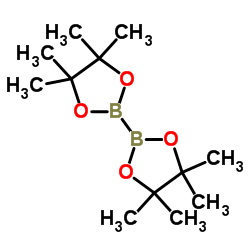
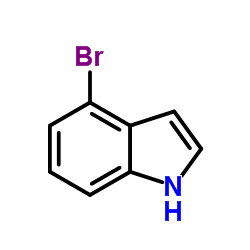


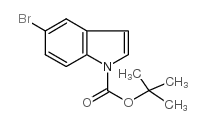
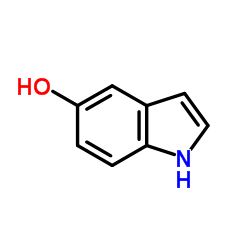
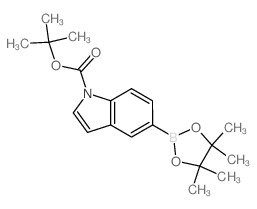 CAS#:777061-36-6
CAS#:777061-36-6 CAS#:1011-65-0
CAS#:1011-65-0
